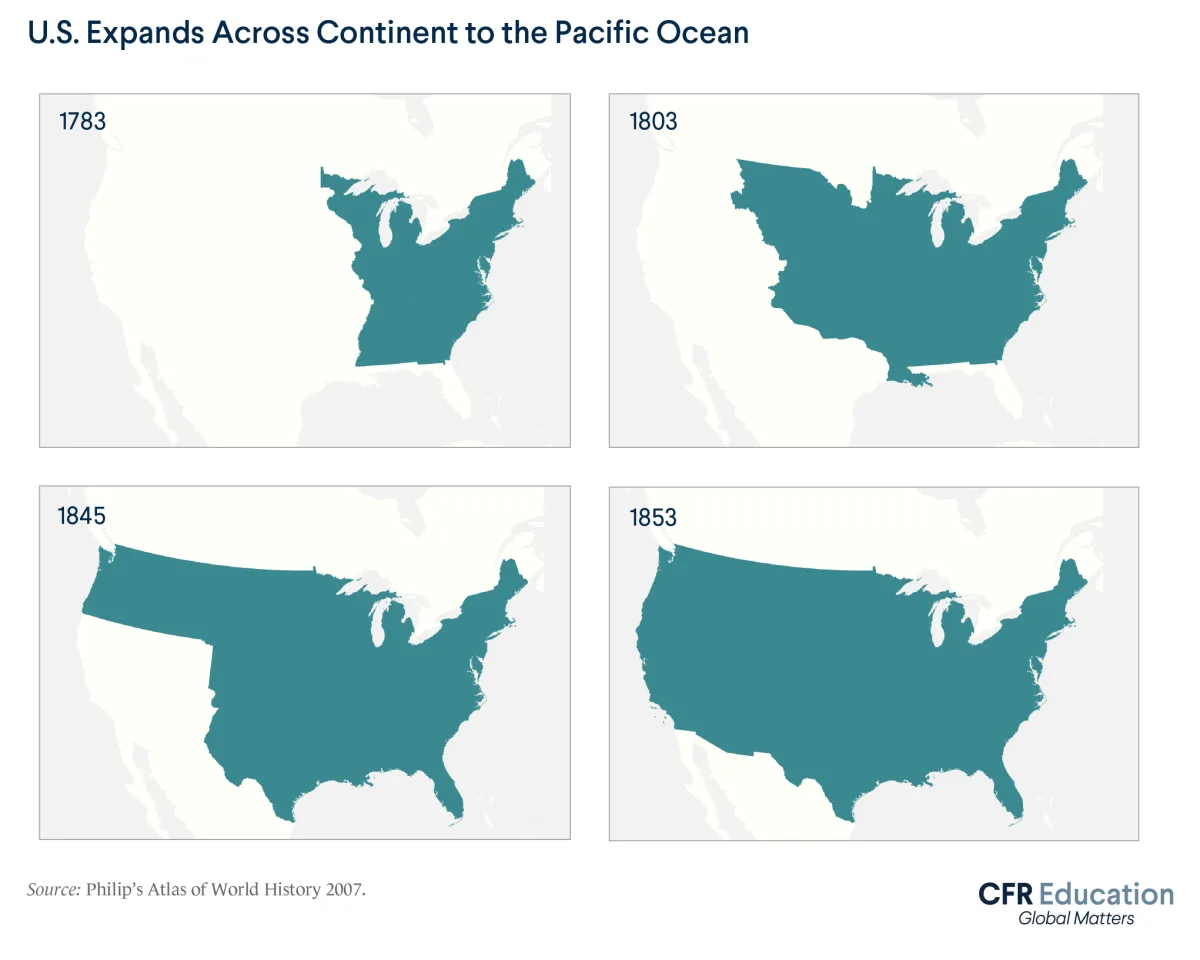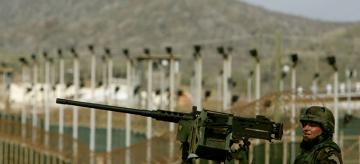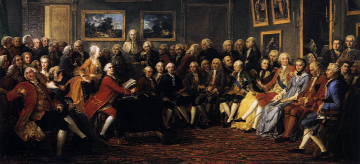How Did the United States Become a Global Power?
Learn how domestic expansion and three wars—the Spanish-American War, World War I, and World War II—transformed the United States’ standing in the world.
With the world’s largest economy, hundreds of overseas military bases, and leadership positions in various international institutions, the United States is an undeniable global power.
But this was not always the case.
For much of the country’s history, presidents shielded the nation from international affairs. The first U.S. president, George Washington, declared in his farewell address, “It is our true policy to steer clear of permanent alliance with any portion of the foreign world.” In particular, he feared the consequences of involving the United States in Europe’s great power conflicts.
Instead, early American leaders focused on developing the young nation’s economy and expanding domestic territory. U.S. Foreign policy was focused on getting Europe’s imperial powers out of the Western Hemisphere. In their worldview, the Atlantic and Pacific oceans served not as barriers to international leadership but rather as invaluable buffers that would allow the country to grow free of foreign interference.
And, indeed, the United States grew. Through negotiation, purchase, conflict, and conquest, the country more than tripled in size between 1783 and 1853.
Its economy took off after the Civil War. Between 1865 and 1898, coal production rose by 800 percent and railway track mileage by 567 percent. By the middle of the 1880s, the United States had surpassed Britain as the world’s leading producer of manufactured goods and steel. Yet despite their growing wealth, Americans still steered clear of foreign entanglement.
So when did the United States begin to take a more active role in affairs beyond its shores?
This resource examines three wars between 1898 and 1945 that transformed the United States into a preeminent global power.
The Spanish-American War
Let’s first go back to the early 1800s when the United States was still a young and vulnerable country. The United States constantly faced threats from far wealthier and militarily superior European empires. The British, French, and Spanish all controlled territory in the region, from which they had profited immensely.
This European competition troubled U.S. presidents who viewed the Americas as their backyard and rightful sphere of influence. In 1823, President James Monroe warned Europe’s empires not to meddle in the region. Any further colonization would be viewed as a hostile act against the United States.
However, the so-called Monroe Doctrine—although bold—was largely dismissed by Europeans. The United States could not act on its threats. In 1820, the United States accounted for under 2 percent of global gross domestic product (GDP). (Today, the country makes up nearly a quarter of the world’s economy.)
Slowly but surely, this power dynamic shifted throughout the nineteenth century. National independence movements expelled Europe’s empires from their colonies in the region. Meanwhile, technological innovations, such as steamboats, passenger trains, and factory machines, transformed the United States from an agrarian country to an industrial one. Moreover, these changes helped spark newfound prosperity that enabled U.S. expansion across North America.
With this burgeoning power, the United States began to look beyond its shores. In 1853, American Commodore Matthew Perry sailed a contingent of the U.S. Navy to Japan. Perry’s voyage resulted in the opening of diplomatic and trading relations after threatening to attack the island nation, which had been largely closed off to the Western world for the previous two hundred years. Between 1856 and 1863, the United States acquired its first overseas territories—a collection of fifty-nine small, uninhabited islands in the Caribbean Sea and Pacific Ocean. Business interests in those islands’ guano—also known, unceremoniously, as seabird poop—drove this offshore expansion: the resource functioned as a valuable natural fertilizer for farmers to use on their nutrient-depleted soils.
If the guano islands represented the United States’ first step toward overseas expansion, then the Spanish-American War of 1898 served as the country’s first giant leap toward global ambitions. Throughout the 1890s, influential Americans began to call for the United States to acquire geopolitical influence commensurate with its economic strength. As one sign of this stirring ambition, Congress began to approve the construction of battleships—vessels capable of taking on the fleets of other great powers.
The United States put these new warships to use in 1898, launching a war to expel Spain from Cuba. The exact causes of the Spanish-American War are still in dispute. At the time, certain American leaders justified their war efforts by pointing to the explosion of a warship—the USS Maine—for which they initially (but almost certainly incorrectly) blamed Spain. Others argued the United States had a responsibility to support Cuban revolutionaries who were rebelling against Spanish colonizers. Either way, by declaring war, the United States seized an opportunity to remove the last vestiges of the Spanish empire from the Caribbean and the Pacific. The war would cement American influence in the two regions.
After just months of fighting, a defeated Spain agreed to leave Cuba and to cede additional Caribbean and Pacific territories to the United States. As a result, Guam, the Philippines, and Puerto Rico became U.S. possessions. That same year, the United States also annexed the independent country of Hawaii.
Seemingly overnight, the United States came into control of far-flung lands and ruled over their populations. However, many residents of these new U.S. territories did not welcome American occupation. Notably, the United States looked like a European empire in its relationship with its newly acquired territories. Residents of Cuba, Guam, Hawaii, the Philippines, and Puerto Rico lacked the same rights as citizens of the U.S. mainland. American territories also did not have voting representation in Congress. Meanwhile, the United States established military bases in those lands and set up coaling stations for American merchants and warships. Moreover, the United States extracted economic concessions from local industries, and even tested experimental—and often dangerous—medical treatments on residents. A bloody insurgency against U.S. rule broke out in the Philippines, ultimately taking the lives of some four thousand U.S. soldiers and hundreds of thousands of Filipinos. Not surprisingly, those events spawned a potent political backlash. The ensuing anti-imperialist movement took a toll on the enthusiasm of the American public for its new international involvements.
Nonetheless, by the turn of the twentieth century, the United States controlled territory spanning ten thousand miles from Puerto Rico to the Philippines. Its economy had surpassed the United Kingdom's to become the world's largest. Economic growth was supercharged by increased production of steel and the adoption of new sources of power like oil. The United States boasted a powerful—and tested—navy, which could defend U.S. interests both in the Americas and now further afield. Indeed, the United States sent over a thousand marines to Beijing in 1900 to help put down a domestic uprising that threatened U.S. commercial interests.
However, quelling a peasant rebellion and defeating an already-fading Spanish empire would pale in comparison to the United States’ overseas military commitment in just a matter of years.
World War I
After the events of 1898, Presidents William Howard Taft and Woodrow Wilson turned away from expansionism. In particular, Wilson succeeded in keeping the United States out of World War I from 1914 to 1917. Amid a devastating conflict in Europe, Washington adhered to an isolationist approach similar to that of the nineteenth century.
So why did Wilson, a president who successfully ran for reelection in 1916 on the slogan “he kept us out of war,” abruptly change course in 1917 and bring the United States into Europe’s greatest conflict to date?
Two main factors motivated Wilson’s decision. First and foremost, Germany had sunk U.S. ships in the Atlantic, which threatened both American lives and business interests. Second, the British intercepted a secret message known as the Zimmerman Telegram. This message revealed that Germany offered to support Mexico taking over U.S. territory if Germany and Mexico formed a wartime alliance.
Despite these facts, the prospect of going to war in Europe provoked heated controversy. Opponents of intervention argued the United States should not commit its resources to a remote foreign conflict. Meanwhile, proponents of intervention believed that Germany’s aggression necessitated a response. Other pro-war advocates, like President Woodrow Wilson, insisted the United States enter the war to make the world “safe for democracy.” Yet another pro-intervention camp noted that the United States stood to suffer financially if the Allies (namely, the British and French) lost. U.S. banks had lent vast sums of money to the two countries and would suffer massively if the Allies did not prevail.
Ultimately, the United States entered World War I on April 6, 1917. That decision helped the Allies turn the tide of the war. It also afforded the United States a leading role in the eventual peace talks in which Wilson set out to shape the postwar international order.
With Europe in disarray, Wilson outlined an idealistic vision for the future. In his 1918 Fourteen Points speech, Wilson called for imperialism to be dismantled. He laid the groundwork for the principle of self-determination, the concept that groups of people united by common characteristics should be able to determine their political future. And, perhaps most notably, he proposed creating a new international organization dedicated to peaceful diplomacy and collective security. This institution would be called the League of Nations.
Although Wilson succeeded in creating the League of Nations (the precursor to the United Nations), he failed to secure needed public and congressional support for U.S. membership in the organization. With the world’s burgeoning power on the sidelines and the organization’s remaining members mostly failing to respond to security threats, the league ultimately broke down.
Especially after the Great Depression, the United States returned to isolationism, seeking to separate itself from the rising tide of militarism and fascism that swept Europe and Asia during the 1930s. Congress passed a series of neutrality acts aimed at ensuring the United States would stand apart from foreign conflicts. The United States also embraced protectionist economic policies, which further withdrew the country from the global economy. Thus, the United States turned inward. Not until Japan bombed Pearl Harbor in 1941 would the country change course and enter World War II.
World War II
Fighting erupted in Asia and Europe in the 1930s, but the United States remained on the sidelines of World War II until 1941.
U.S. leaders were willing to supply the Allies (including France, the Soviet Union, and the United Kingdom) with loans and weapons in hopes of tilting the outcome of the war. However, the United States had little appetite for sending troops into yet another overseas conflict. The previous war had exacted a terrible toll—over a hundred thousand American lives lost. Moreover, the country was still recovering from the economic fallout from the Great Depression.
This meant that in 1940 just 7 percent of Americans supported the country entering the war.
But on December 7, 1941, Japan bombed the U.S. naval base at Pearl Harbor, killing around 2,400 troops. The attack also damaged and destroyed dozens of planes and warships. The attack unified Americans behind joining the war. Just one day later, the United States issued a declaration of war against Japan. Soon thereafter, the United States was at war against Germany and Italy after both declared war on the United States.
At the time, Adolf Hitler’s Germany had enjoyed a series of military successes. France had surrendered after just six weeks of fighting. The Soviet Union, which had previously signed a nonaggression pact with Germany, was caught off guard when Germany invaded it earlier that year. Britain found itself isolated and outnumbered.
However, when the first U.S. troops landed in Europe in early 1942, the tide slowly began to shift against the Axis powers. Germany soon found itself caught between a Soviet counteroffensive in the east and a U.S.-led offensive in the west. Germany ultimately surrendered on May 7, 1945. Japan followed soon thereafter, surrendering on August 14 after the United States dropped atomic bombs on the cities of Hiroshima and Nagasaki. President Harry Truman decided to deploy atomic weapons to avoid a costly invasion of Japan.
By the war’s end, some sixteen million Americans served in Europe and the Pacific, the largest mobilization of U.S. military service members in the country’s history. The fighting also came at a tremendous cost: more than four hundred thousand American soldiers died. Some seventy million people perished as a result of the violence, disease, and famine that accompanied World War II.
Building the Postwar Peace
As the smoke cleared, the United States stood victorious and with unprecedented global power. In addition to towering as the world’s military heavyweight, the United States boasted the most valuable currency—the dollar—to which all other major currencies had become fixed. In addition, the country’s economy had taken off during the war, nearly doubling in size between 1939 and 1945. In stark contrast, Western Europe’s economy contracted by 18 percent and Japan’s was cut in half.
This economic and military strength uniquely positioned the United States to promote postwar peace and prosperity. And this time, instead of retreating to the Western Hemisphere as it did following World War I, the United States resolved to prop Europe back up and rebuild Japan.
In particular, the United States sought to ensure that Europe’s physical, economic, and political collapse did not allow the Soviet Union to expand its influence. Washington’s wartime alliance with Moscow began to transform into the geopolitical rivalry of the Cold War. To shore up the United States’ allies, Secretary of State George C. Marshall announced a multibillion-dollar aid plan in 1947. In addition, the United States agreed to provide military assistance to rebuild Western Europe’s armies. In 1949, the United States, Canada, and ten European countries formed a military alliance known as the North Atlantic Treaty Organization (NATO). The cornerstone of this alliance was collective security, the pledge that an attack on one country would be treated as an attack on all. This groundbreaking peacetime alliance made the United States—with its outsized military strength—effectively the defender of Western Europe.
Likewise, in Asia, the United States occupied and assisted in the postwar reconstruction of Japan. When Mao Zedong brought a communist government to power in China in 1949 (despite U.S. opposition), the United States established several bilateral alliances with countries in the region to prevent the further spread of communism. American involvement in the Korean War confirmed the United States’ readiness to use its military strength to resist communist expansionism.
The United States took the lead in creating a series of international institutions to promote cooperation on global issues. Specifically, the United Nations, the World Bank, and the International Monetary Fund were established to govern international security and monetary policy. The United States has championed this global system of multilateral institutions—known as the liberal world order—for the past seventy-five years.
At the close of World War II—the deadliest conflict in human history—British Prime Minister Winston Churchill declared that the United States stood “at the summit of the world.”
What is the United States’ place in the world today?
Since World War II, the United States has typically played an active leadership role in global institutions. Washington has cultivated close relationships with allies who share the country’s outlook on democracy and world order.
But in recent years, Americans have once again come to question whether the United States benefits from playing such an enormous international role.
Many Americans had grown disillusioned with U.S. military intervention following long, costly wars in both Afghanistan and Iraq—conflicts undertaken in the aftermath of the 9/11 terrorist attack on the U.S. homeland that killed nearly three thousand people. Domestic problems, made worse by the 2007 financial crisis and resulting recession, reinforced doubts about maintaining a leading American role in the world. Signs of this reluctance surfaced during the presidency of Barack Obama but increased dramatically under President Donald J. Trump. The Trump administration aggressively advanced an “America First” ideology in which he questioned the merits of decades-long alliances and international partnerships. During his presidency, Trump started proceedings to remove the United States from the World Health Organization amid a global pandemic; pulled the United States from the Paris Agreement, which seeks to address climate change; and threatened to withdraw the country from NATO. His isolationist and unilateralist policies harkened back to the era after World War I, during which the United States turned away from international engagement and leadership.
However, the United States today is showing some signs of changing course once more. President Joe Biden has repudiated some of his predecessor’s policies and has sought to restore the United States as a leader on the global stage. The Biden administration has reasserted that strong alliances enhance U.S. power around the world. In his first speech on foreign policy as president, Biden declared to the world, “America is back.”
But declaring this is one thing, putting it into practice is quite another. The world does not look as it once did following World War II. China is on the rise, democracy is in retreat, and unprecedented climate, economic, health, and security threats abound. Meanwhile, at home, the United States faces a wide range of challenging issues, including a costly pandemic, racial injustice, economic uncertainty and inequality, and far-right extremism. Amid these challenges, the future of U.S. foreign policy and the nature and scope of its relationship with the world is again a topic of fierce debate.






